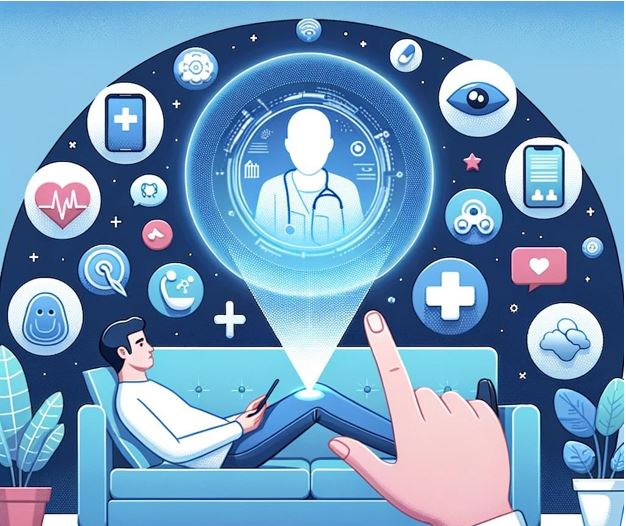Mental well-being sits at the forefront of global concerns. As we navigate the ups and downs of life, technology offers a beacon of hope. As telepsychiatry revolutionizes remote therapeutic sessions, the rise of mental health apps poses an intriguing question: Will these apps redefine the future of telepsychiatry? With their promise of increased accessibility, real-time monitoring, and personalized interventions, mental health apps are poised to become supplementary tools and potentially integral components in the evolving landscape of digital mental health care.
Mental health apps serve as digital bridges, connecting users to resources, exercises, and tools. Think of them as mini-therapists in your pocket. Whether it’s guided meditations, mood trackers, or cognitive exercises, these apps cater to a spectrum of needs. Platforms like Calm offer relaxation techniques, while others focus on cognitive-behavioral strategies.
The Emergence of Anti-Dating Apps
While most apps focus on mental well-being, a niche category, “anti-dating” apps, has made its mark. According to ExpressVPN, apps like Mend cater to those healing a broken heart, guiding them through stages of grief and recovery. BumbleBFF and Atleto, on the other hand, pivot from romance to pure, platonic friendships. They champion the idea that not all connections need a romantic spark. Some require shared interests and mutual respect.
Telepsychiatry: A New Age Solution
Instead of traditional face-to-face sessions, therapists and clients meet in virtual rooms. No more commutes, waiting rooms, or scheduling woes. Just a click, and you’re in your therapist’s virtual office.
Benefits of Telepsychiatry
Overcoming Barriers
The perks of telepsychiatry are hard to ignore. One of the main advantages of telepsychiatry is its ability to overcome geographical barriers and increase access to mental health services. In rural and remote areas, the shortage of mental health professionals often leaves individuals without adequate care. Telepsychiatry provides a solution by allowing patients to connect with psychiatrists and therapists remotely, eliminating the need for long-distance travel. It’s also lighter on the pocket. And let’s remember the comfort factor. Many find opening up from their own space—a personal haven—much easier than in a clinical setting.
Improving Timely Interventions
Telepsychiatry also enables timely interventions, especially in emergencies. In traditional mental health care settings, individuals experiencing a mental health crisis may face long appointment waiting times. With telepsychiatry, individuals can receive immediate support and intervention, reducing the risk of escalation and improving outcomes. This is particularly important for individuals with severe mental illnesses who may require urgent care.
Challenges in Telepsychiatry
Technological Limitations
While telepsychiatry offers numerous benefits, it also presents some challenges. One of the primary challenges is technological limitations. Access to reliable internet connections and adequate technology infrastructure is essential for effective telepsychiatry services. In areas with limited connectivity or outdated technology, video and audio quality may be compromised, hindering the effectiveness of remote consultations.
Privacy and Confidentiality
Maintaining privacy and confidentiality is another significant concern in telepsychiatry. As patient information is transmitted electronically, it is crucial to ensure secure platforms and encryption methods to protect sensitive data. Mental health professionals must adhere to strict privacy regulations and ethical guidelines to maintain patient confidentiality and trust.
Licensing and Reimbursement
Licensing and reimbursement issues are additional challenges in telepsychiatry. Mental health professionals must be licensed in the state or country where the patient is located. This can be a barrier, mainly when providing services across state or international borders. Reimbursement policies also vary, and mental health professionals may face difficulties in receiving adequate payment for telepsychiatry services.
Establishing Therapeutic Relationships
Developing therapeutic relationships through telepsychiatry can be more challenging compared to face-to-face interactions. The absence of physical presence and non-verbal cues may impact the therapeutic alliance between the patient and the provider. Mental health professionals must adapt their communication skills and employ strategies to establish rapport and trust in a virtual setting.
Innovations in Telepsychiatry
Mobile Applications for Mental Health
The rise of mobile applications for mental health has brought forth innovative ways to deliver telepsychiatry services. Mental health apps like Talkspace, Moodfit, and Calm provide individuals with convenient access to therapy, self-help resources, exercises, and support communities. These apps allow users to connect with mental health professionals through secure messaging, video calls, or virtual support groups, empowering individuals to manage their mental well-being anytime and anywhere.
Artificial Intelligence and Virtual Reality
Artificial intelligence (AI) and virtual reality (VR) technologies can potentially enhance telepsychiatry services. AI-powered chatbots can provide immediate support and resources to distressed individuals, offering personalized recommendations based on their symptoms and needs. VR therapy can simulate real-life situations and environments, providing exposure therapy for anxiety disorders and phobias. These technologies could revolutionize mental health care by expanding treatment options and improving outcomes.
Remote Monitoring and Wearable Devices
Remote monitoring and wearable devices enable mental health professionals to gather real-time data on patients’ physiological and behavioral patterns. For example, wearable devices can track heart rate, sleep patterns, and activity levels, providing valuable insights into a patient’s mental well-being. This data can inform treatment plans and help monitor progress, leading to more personalized and effective interventions.
Looking Forward: Predictions and Possibilities
The future is bright. With advancements in artificial intelligence, future apps might offer feedback or even predict upcoming mood shifts. There’s also chatter about virtual reality making its way into telepsychiatry. Imagine addressing your fears in a controlled, virtual environment, with your therapist guiding you in real-time. Of course, as we tread new grounds, ethics and regulations will play a pivotal role in shaping these advancements.
Conclusion
In a world where mental well-being is paramount, mental health apps and telepsychiatry emerge as heroes. They signify hope, accessibility, and innovation. As we embrace this digital therapeutic revolution, one thing is clear: mental health care is evolving, and it’s for the better.






